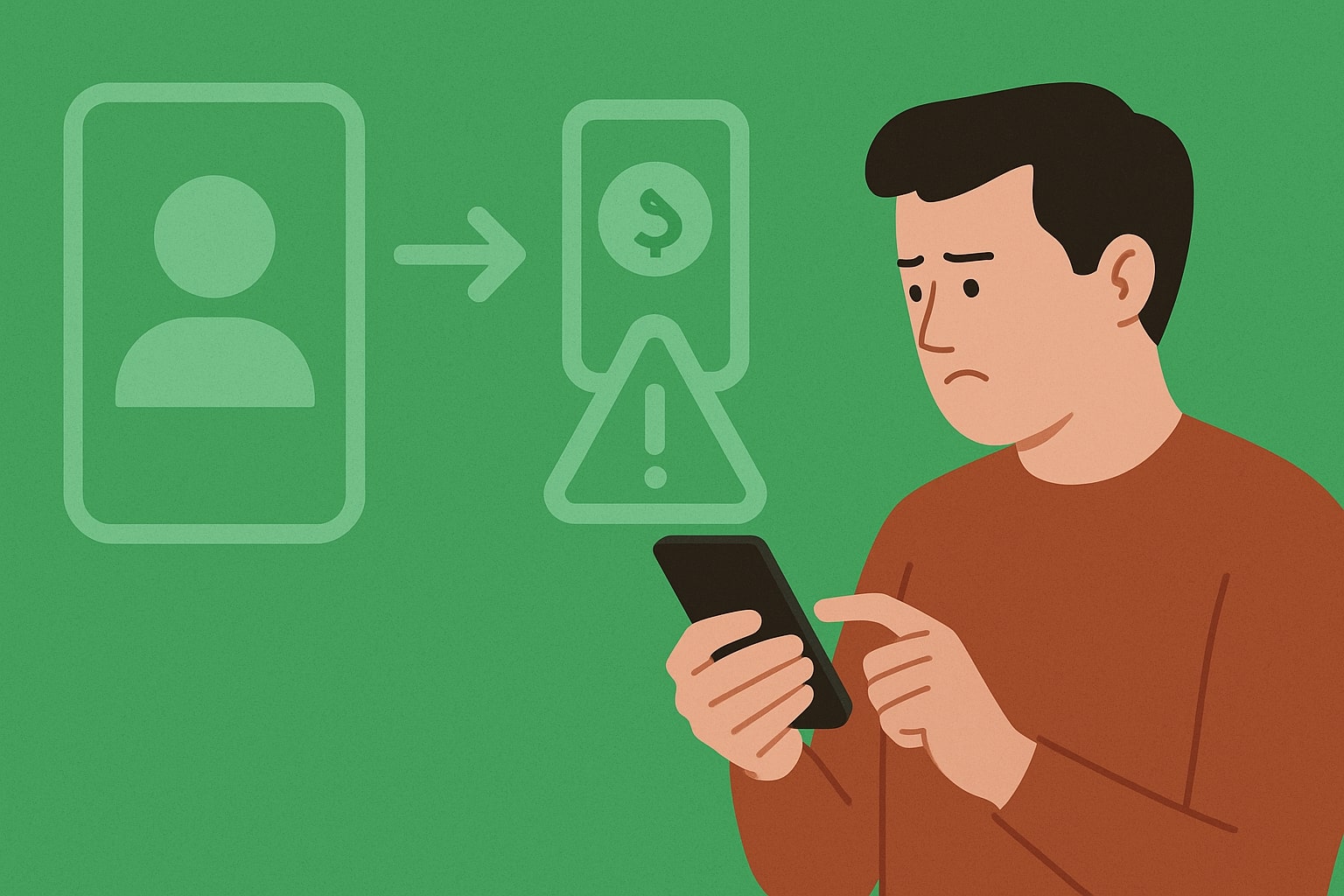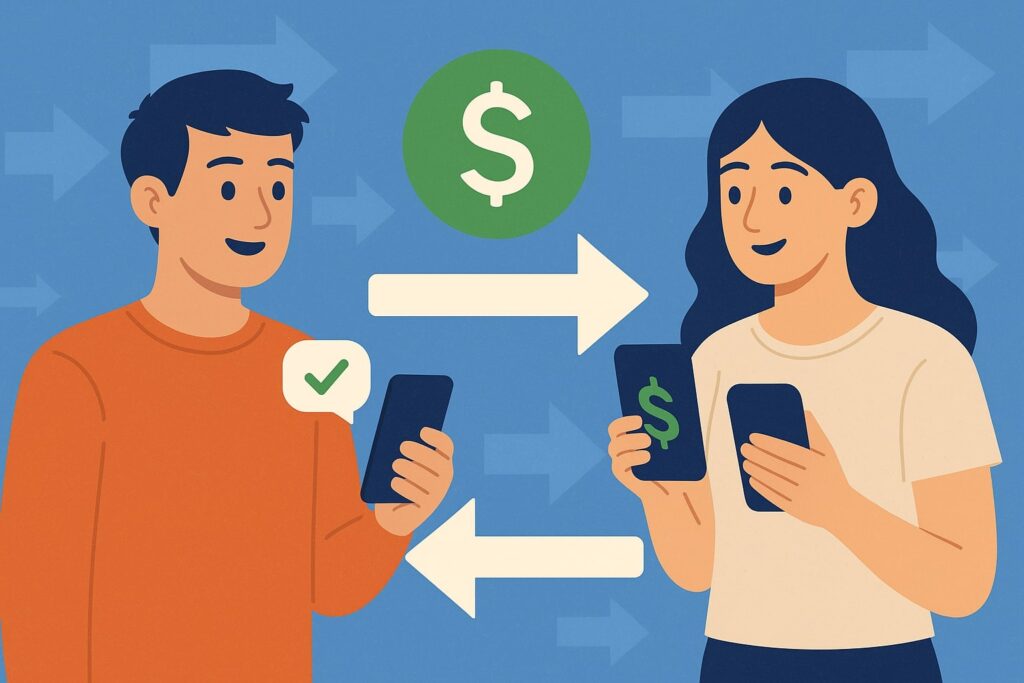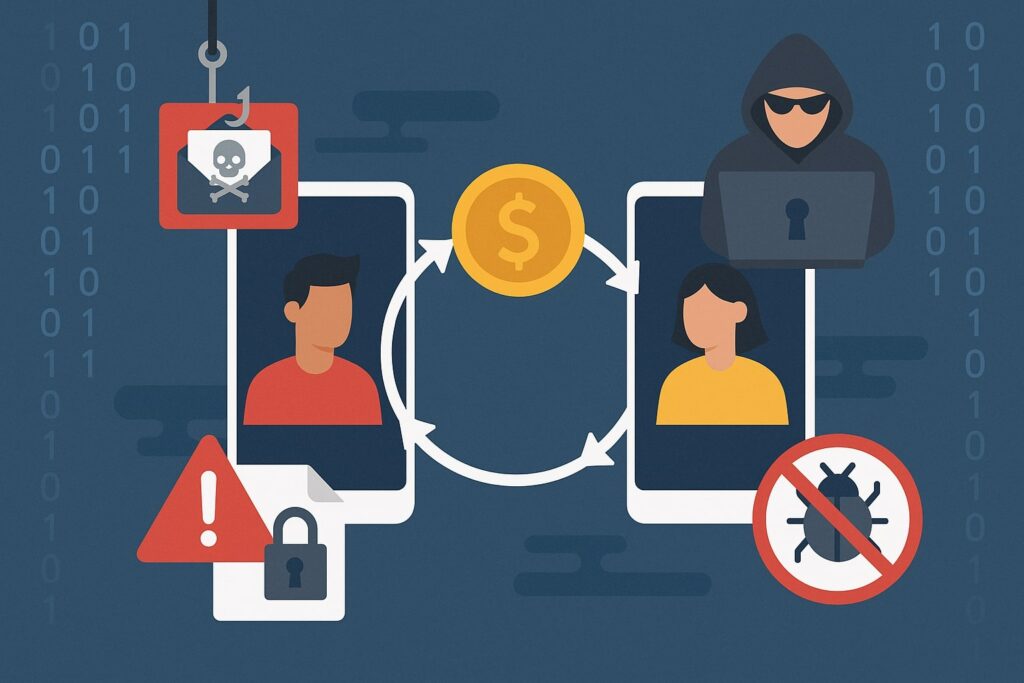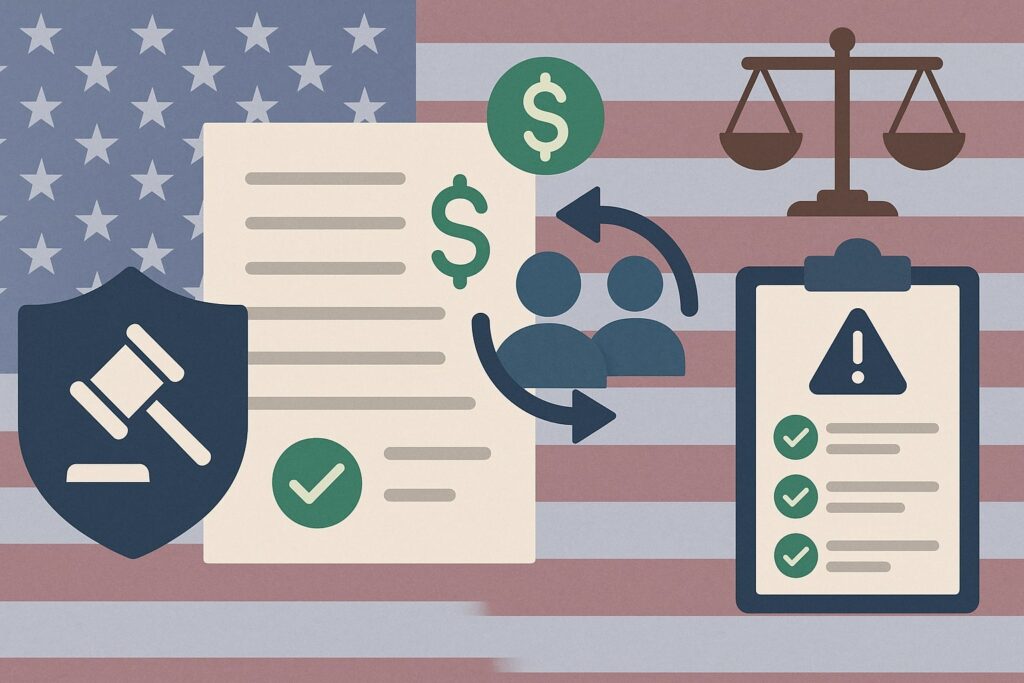
By p2pbusinesspayments October 26, 2025
Peer-to-peer transfers are now woven into daily life in the United States. Whether you’re paying a contractor, splitting dinner, reimbursing a sitter, or moving funds between accounts, peer-to-peer transfers feel instant, simple, and nearly invisible.
That convenience, however, also makes peer-to-peer transfers a prime target for fraudsters who rely on speed, social engineering, and the irreversibility of many push payments.
In 2024 alone, Americans reported a record $12.5 billion in fraud losses to the Federal Trade Commission, a 25% jump from 2023—an unmistakable signal that digital payments, including peer-to-peer transfers, are in scammers’ crosshairs.
This guide explains how peer-to-peer transfers work, where security gaps appear, and how U.S. consumers and small businesses can reduce risk without giving up the speed of modern money movement.
It blends practical checklists with policy context, because liability and dispute rules shape outcomes after something goes wrong. You’ll see where Regulation E fits, what “authorized push payment” fraud means in practice, and how trends like real-time rails (including the Federal Reserve’s FedNow Service) elevate both opportunity and attack surface.
By the end, you’ll know how to verify recipients, harden devices, contain damage when incidents occur, and set sensible policies for accepting peer-to-peer transfers in your life or business.
Throughout, we use the term “peer-to-peer transfers” deliberately and often. That’s because understanding the specific risks of peer-to-peer transfers—and how they differ from card transactions or old-fashioned checks—is essential to protecting your money in 2025.
How Peer-to-Peer Transfers Work—and Why They’re Different

Peer-to-peer transfers move funds directly from one account to another on a push-payment basis. Unlike pull-based card transactions where a merchant initiates a charge, peer-to-peer transfers depend on the sender to authorize and “push” money out. U.S. consumers typically initiate peer-to-peer transfers inside mobile apps or online banking.
The transaction then rides one of several rails: internal ledger transfers within the app, Automated Clearing House (ACH) credits, debit network rails, or—more recently—instant rails that settle within seconds.
Because peer-to-peer transfers are push payments, they frequently lack the robust chargeback and purchase-protection frameworks common with cards. That creates a liability environment where mistaken or manipulated authorizations can be final.
Two major instant rails matter in 2025: The Clearing House’s RTP network and the Federal Reserve’s FedNow Service. FedNow has been scaling quickly—by Q3 2025, the Fed reports 2.5 million settled payments in the quarter, totaling about $307 billion, with strong quarter-over-quarter growth.
As more banks and credit unions bring FedNow to consumers and businesses, peer-to-peer transfers will feel even more immediate. But with speed comes compressed time for fraud detection and consumer reflection, which is why instant rails must be paired with strong front-end verification and after-the-fact recovery playbooks.
Finally, remember that “peer-to-peer transfers” is a broad umbrella. It includes person-to-person payments between friends, casual marketplace deals, reimbursements for small jobs, and even some business-to-consumer or consumer-to-business use cases.
The security stakes vary by scenario. Paying your long-time landlord is not the same as sending money to a stranger from a social post. Understanding the nuances of peer-to-peer transfers is the first step toward using them safely.
The U.S. Fraud Landscape Touching Peer-to-Peer Transfers (2024–2025)
Fraud data from 2024 shows the risk environment around peer-to-peer transfers is intensifying. The FTC’s 2024 Data Book highlights $12.5 billion in consumer-reported losses—a 25% increase—with impostor scams among the top categories.
The FBI’s Internet Crime Complaint Center (IC3) similarly reports 2024 losses exceeding $16 billion, underscoring how cyber-enabled crime continues to scale. These numbers do not isolate peer-to-peer transfers alone, but they illustrate the ecosystem pressures that spill into P2P apps, bank-to-bank push payments, and instant rails.
A few trend lines are especially relevant for peer-to-peer transfers. First, social channels are a major vector for fraud origination.
In early 2025, Chase announced it would block or delay some Zelle payments when they appear to originate from social-media interactions—a direct response to scams that begin in DMs and community groups where buyers and sellers lack a prior relationship.
Second, “task” and “investment” scams—often crypto-touching—continue to evolve, mixing small early payouts with sophisticated spoofing to induce larger transfers.
Third, as instant rails grow (FedNow, RTP), the window to detect, freeze, or recall a suspect transfer narrows, which raises the premium on up-front identity proofing, ongoing monitoring, and strong customer education at the point of initiation.
For consumers and small businesses, the takeaway is straightforward: peer-to-peer transfers are convenient and often safe, but the macro fraud environment is worsening. The right controls—verification, device hygiene, transaction limits, and recovery playbooks—make all the difference in outcomes when seconds matter.
Common Attack Vectors Targeting Peer-to-Peer Transfers

Impostor & Social-Engineering Scams: How Criminals “Authorize” Your Own Payment
The #1 threat to peer-to-peer transfers is not a Hollywood-style hack; its persuasion. Impostors pretend to be a bank agent, government official, seller, or even a friend. They create urgency—“your account is locked,” “your child is in trouble,” “this deal ends in five minutes”—and walk you through sending a peer-to-peer transfer to “fix” the problem.
Because you tap “Send,” the payment is technically “authorized,” which complicates recovery compared to an unauthorized card charge. Zelle and multiple banks stress that P2P should be used to pay people you know and trust, not strangers in online marketplaces.
Chase’s 2025 change to block or delay social-media-originated Zelle payments reflects the reality that many scams start in DMs or listings.
To defend against this, treat any unexpected payment instruction with suspicion. Hang up and call the official number on your card or bank website. Never move money to “prove” anything to a bank agent.
Verify identities out-of-band: call the family member, video-chat the contractor, or ask the seller to send a micropayment first and confirm receipt before larger amounts. For peer-to-peer transfers, assume that once funds leave your account, retrieval may be unlikely—so take the extra minute up front.
Account Takeover, SIM-Swap, and Device-Level Compromise
If scammers can’t talk you into sending peer-to-peer transfers, they’ll try to send them for you by taking over your device or account. Phishing pages harvest app credentials; SIM-swap attacks reroute one-time passcodes; mobile malware steals session tokens.
Once inside, criminals enroll new devices, reset recovery methods, and trigger peer-to-peer transfers to mule accounts. The FBI’s IC3 warns that cyber-enabled crime leverages these multi-step compromises, and losses mount quickly because instant payments settle in seconds.
Good hygiene blocks much of this: enable passkeys or phishing-resistant MFA, lock down your wireless account with a port-out PIN, and set alerts for new device sign-ins and high-value sends. Keep your OS and bank app updated, and avoid sideloaded apps or “helpers” that demand accessibility permissions.
A further protection is to segment your financial life. Use a separate bank or low-balance account for day-to-day peer-to-peer transfers, keep caps on single-transaction and daily limits where available, and disallow new payees unless re-verified.
If you manage family devices, enable Screen Time or Google Family Link to prevent unapproved app installs that could undermine P2P security.
Authorized Push Payment (APP) Fraud and “No Purchase Protection” Pitfalls
APP fraud happens when you authorize a payment under false pretenses—paying a fake seller, a spoofed landlord, or an impostor “fraud department.” In APP cases, traditional Regulation E protections for unauthorized electronic fund transfers may not apply, because the transaction was initiated by you.
Many peer-to-peer services warn that they do not offer purchase protection for goods and services, especially when paying strangers. That’s why banks and networks emphasize using P2P only with trusted contacts, and some now add friction or blocks when signals suggest a marketplace purchase.
If you insist on buying from an unknown seller, insist on a method with purchase protection, or meet in person with escrow-like safeguards.
If an APP scam hits you, speed is everything. Contact your bank or payment app immediately, request a recall if the payment has not yet been withdrawn by the recipient, and file reports (FTC, IC3).
Some platforms have expanded voluntary reimbursement policies for certain imposter scams, but coverage varies and qualifications can be strict, so do not rely on reimbursement after the fact.
QR Codes, Payment Links, and “Deepfake” Payee Profiles
Criminals increasingly exploit QR codes and payment links to misdirect peer-to-peer transfers. A bogus code on a parking meter or a spoofed payment handle that looks nearly identical to a known contact can divert funds in one tap.
Meanwhile, AI-generated profile photos, cloned voices, and convincing business listings provide a veneer of legitimacy. Defend by initiating the payment from your own saved contacts or the app’s verified directory rather than scanning random codes.
When paying a new business, find the account or $cashtag from the company’s official website or invoice, and send a $1 test first. If you run a business that receives peer-to-peer transfers, publish your official handle prominently and rotate QR codes, so stale or doctored versions don’t get reused by scammers.
Crypto-Linked “Task” and Investment Scams That Start in P2P
A growing class of scams recruits victims via text, WhatsApp, or social channels to perform “tasks” or “boost” products for small initial payouts. The con then escalates to larger “deposits” or off-platform crypto buys, with the promised rewards never materializing.
Peer-to-peer transfers frequently appear in the early stages, where scammers build trust before steering targets into unregulated exchanges or fake dashboards. The FTC publicly warned in 2024 about these job-like “task scams,” reporting more than $220 million stolen in the first half of the year.
If an opportunity requires you to be paid, or pushes you to move funds off a mainstream platform, stop—no legitimate employer asks you to pre-fund your own wages.
U.S. Rules, Liability, and Policy Shifts That Affect Peer-to-Peer Transfers

Where Regulation E Helps (and Where It Doesn’t)
The Electronic Fund Transfer Act (EFTA) and Regulation E govern consumer electronic transfers. Under Reg E, a transfer is “unauthorized” when it’s initiated by someone other than the consumer and without authorization.
That generally covers true account takeovers—fraudsters sending peer-to-peer transfers without your consent. In those cases, banks must investigate timely error notices and, if appropriate, make the consumer whole.
But if you approved the payment (even after being deceived), it may be considered “authorized,” and Reg E protections may not apply.
The Consumer Financial Protection Bureau’s (CFPB) official FAQs lay out the definitions and timelines for error resolution that consumers should know before relying on peer-to-peer transfers for purchases.
To preserve your rights, report suspected unauthorized peer-to-peer transfers immediately—delays can limit recovery. Document the timeline, keep screenshots, and respond to your bank’s requests during the investigation window.
If the dispute involves an “authorized” but induced payment, file with your bank anyway; some institutions have voluntary reimbursement policies for specific imposter scams, and law enforcement reports may help in inter-bank recovery efforts.
Platform Policies and Evolving Reimbursement Practices
In the last two years, public pressure pushed several platforms and banks to strengthen consumer outcomes for certain scams. Zelle, for instance, signaled a policy shift to help some victims of imposter scams get reimbursed, though consumer experiences remain mixed and eligibility criteria can be narrow.
Consumers should not assume purchase protection exists for peer-to-peer transfers, and should consult their bank’s current policy language before relying on reimbursement. When in doubt, choose a protected method for goods and services.
Bank-level controls are also changing. In 2025, Chase announced it would block or delay Zelle payments tied to social-media interactions, a targeted move to cut off a prolific scam funnel.
Expect more banks to add context-aware friction—delays for first-time recipients, warnings for marketplace phrases, or blocks where fraud rates spike—especially for peer-to-peer transfers that look like commerce.
CFPB Oversight of Big Tech Payment Apps
A notable regulatory development in 2025 is the CFPB’s final rule bringing larger nonbank digital wallet and payment app providers under its supervisory umbrella. The rule enables ongoing examinations for compliance with federal consumer financial laws, including data privacy and error resolution.
For peer-to-peer transfers, this means the biggest players—think PayPal, Venmo, Cash App, and emerging “super apps”—face closer scrutiny of disclosures, dispute handling, and fraud controls, which should translate into clearer rules of the road for consumers and more consistent outcomes across platforms.
Technical Controls and Habits That Make Peer-to-Peer Transfers Safer
Lock In Strong Identity: Passkeys, Phishing-Resistant MFA, and Out-of-Band Checks
Turn on passkeys or strong MFA wherever your bank or payment app supports it. Passkeys resist phishing by binding authentication to your device’s secure enclave or hardware security module.
If SMS codes are your only option, add a carrier PIN to deter SIM swaps, and never read a one-time code to anyone—even a supposed bank agent.
For high-risk peer-to-peer transfers (new recipients, large amounts, or marketplace transactions), perform an out-of-band verification: call the recipient at a known number, confirm the handle from an independent website, or exchange a $1 test before you send more.
These extra steps slow down social-engineering attacks that trick you into authorizing peer-to-peer transfers you did not truly intend.
On the back end, check whether your bank allows recipient whitelists, “known payee” designations, or higher friction for first-time recipients.
Opt into real-time alerts for sign-ins, device enrollments, and sends above your typical amount. Peer-to-peer transfers are safest when systems know your normal patterns and flag anomalies fast.
Harden Your Devices and Apps: Updates, Permissions, and Isolation
Keep your phone’s OS and banking apps fully updated—security patches fix the very vulnerabilities that malware uses to hijack peer-to-peer transfers. Avoid sideloading apps and be wary of “screen sharing” or “remote support” tools that grant strangers the ability to view or control your device.
Review app permissions; revoke accessibility and notification access from anything that doesn’t require it. Use biometric locks and enable automatic screen lock. If you store recovery codes, keep them offline in a secure place.
Consider “financial isolation”: dedicate one device profile, browser, or even a low-limit account specifically for peer-to-peer transfers. Limit daily send amounts where your bank allows it.
If your household shares devices, set up separate profiles to keep children’s apps from undermining your security posture. The small inconvenience pays for itself the one time a scam tries to turn your convenience app into a cash-out channel.
Monitor, Limit, and Log: Rate-Limit Your Risk
Speed is a defining feature of peer-to-peer transfers, so your controls should create speed bumps at the right moments. Enable per-transaction and daily caps; require step-up authentication for sends over a threshold; and keep a running log of payment handles you’ve verified.
If you operate a small business that accepts peer-to-peer transfers, rotate QR codes, maintain an internal list of official handles, and publish them on your website with verification cues (branding, consistent casing, and a single canonical link).
When an employee leaves or a device is lost, immediately revoke access to payment accounts and regenerate recovery keys. These rate-limit habits keep one mistake from turning into a drain.
A Small-Business Playbook for Accepting Peer-to-Peer Transfers
Set the Rules of Engagement (and Put Them in Writing)
If your U.S. small business accepts peer-to-peer transfers, treat them as a distinct payment channel with its own policy. Specify which services you accept (and which you don’t), where to find your verified handles, whether you add a service fee, and when a payment counts as “received.”
Publish that policy on your site and invoices, and repeat it at checkout. Because peer-to-peer transfers generally lack purchase protection, tell customers what happens in disputes and returns—e.g., refunds only to the original method after goods are returned in sellable condition.
For higher-risk scenarios (e.g., high-ticket items or shipping to new addresses), route the transaction to a method with chargeback rights and address verification, and require signed terms that explain why.
Staff training is a must. Employees should know not to accept peer-to-peer transfers that were “accidentally” overpaid, not to issue refunds to a different handle, and not to edit your QR codes without authorization.
A simple script—“We only accept peer-to-peer transfers to the handle printed on this invoice and displayed at our checkout. We do not accept payments initiated from social-media messages.”—closes a popular scam loop.
Chase’s 2025 move to curb social-originated Zelle underscores how vital that boundary is for commerce-like payments.
Reconciliation, Records, and Incident Response
Peer-to-peer transfers can be efficient for pop-up sales, farmers’ markets, and home services, but you still need clean books. Tie each payment handle to a specific bank account. Use unique invoice numbers or short codes in payment memos so deposits reconcile quickly.
Export transaction histories weekly, and back them up. For taxes, classify peer-to-peer transfers correctly as business income in your accounting software; consult a CPA for state and federal obligations.
Create an incident response runbook tailored to peer-to-peer transfers. If a customer sends funds to the wrong handle, who do you contact? How fast can you alert your financial institution, the payment app, and (for larger losses) the FBI’s IC3?
Practice the workflow before you need it. The sooner you escalate, the better your odds—especially on instant rails where minutes matter.
A Consumer Checklist for Safer Peer-to-Peer Transfers
Before You Send: A 60-Second Verification Routine
For any peer-to-peer transfer to a new or infrequent recipient, run this quick routine:
- Confirm identity out-of-band. Call the person or business using a number from a trusted source (your contacts, official website).
- Validate the handle exactly. Look for subtle character swaps and impostor profiles.
- Send a $1 test. Confirm receipt and a confirming message from the recipient.
- Re-read the reason. If urgency is the only reason to send, don’t.
- Choose the right rail. For goods from strangers, use a method with purchase protection. For bill splits and known payees, peer-to-peer transfers are fine.
If anything feels off—unusual grammar, voice pitch that doesn’t sound right, insistence on secrecy—stop. The best way to secure peer-to-peer transfers is to slow down before you hit “Send.”
If Something Goes Wrong: Rapid Response, Right Reports
If you suspect a fraudulent or mistaken peer-to-peer transfer, act immediately:
- Contact your bank or payment app and request a recall or block if the funds haven’t been withdrawn.
- If you bank-enrolled with Zelle, report through your bank; otherwise use Zelle’s scam reporting portal.
- File with the FTC and the FBI’s IC3, which helps law enforcement spot patterns and sometimes coordinate recovery.
- Document everything: timestamps, screenshots, handles, and message threads.
Remember: unauthorized electronic fund transfers (someone else initiated them) may trigger Regulation E protections, but authorized payments induced by scams may not. Still, file the claim—some banks and platforms now reimburse certain imposter scams, and fast, complete reporting can only help.
What’s Next: Trends That Will Shape Peer-to-Peer Transfers in 2026
Real-Time Rails, Context-Aware Friction, and Stronger Oversight
Instant rails will keep expanding as FedNow and RTP add participants and features. That means peer-to-peer transfers will be even more instantaneous—and fraud controls must shift left, toward initiation.
Expect more “confirmation of payee”-style name checks, richer behavioral analytics, and contextual friction (cool-offs for first-time recipients, extra warnings for marketplace keywords, and blocks when social-media signals are present).
Chase’s 2025 policy on Zelle/social-media is likely the first of many such measures. Meanwhile, the CFPB’s supervision of large nonbank payment apps should standardize disclosures, privacy practices, and error-resolution processes—signs that the policy environment is catching up to the realities of peer-to-peer transfers.
For consumers and small businesses, the key is to welcome a little friction when it protects your money.
Frequently Asked Questions (U.S.-Specific)
Q1) Are peer-to-peer transfers safe to use for everyday payments?
Answer: Peer-to-peer transfers are safe when you pay people you know and verify recipients carefully. The biggest risk comes from impostor and marketplace scams that trick you into authorizing payments.
Because many peer-to-peer transfers lack purchase protection, treat unknown sellers with caution and consider protected rails for goods and services. Fraud losses across the U.S. rose sharply in 2024, so vigilance matters.
Q2) What’s the difference between an “unauthorized” transfer and an “authorized” one under Regulation E?
Answer: An unauthorized transfer is initiated by someone else without your permission (e.g., account takeover), and Regulation E requires your bank to investigate promptly and—if appropriate—provide reimbursement.
If you approved the payment (even if you were deceived), it may be treated as authorized; Regulation E may not require reimbursement. Always report quickly; timelines affect outcomes.
Q3) Do Zelle, Venmo, or Cash App offer purchase protection?
Answer: Generally, peer-to-peer transfers are designed for people you know and trust; many do not include purchase protection for marketplace buys.
Policy details and voluntary reimbursements vary by platform and bank and have evolved recently—check current terms before relying on reimbursements after a scam.
Q4) What if I paid the wrong person by mistake?
Answer: Contact your bank or app immediately and request a recall. If the recipient hasn’t withdrawn the funds or agrees to return them, you may recover the money. File reports with the FTC and IC3 to document the incident. Speed and documentation are critical to reversing peer-to-peer transfers.
Q5) How fast are instant peer-to-peer transfers growing in the U.S.?
Answer: FedNow’s volumes and values have been climbing rapidly; by Q3 2025 it settled about 2.5 million payments in the quarter totaling roughly $307 billion, reflecting increasing adoption by banks and credit unions. Growth increases convenience—and the need for strong up-front verification.
Q6) Why are scams increasingly starting on social media or messaging apps?
Answer: Social platforms provide scale and intimacy—scammers can DM thousands and create a false sense of trust. In response, some banks, like Chase, are adding friction by blocking or delaying Zelle payments linked to social-media interactions. Treat any payment request from a new social contact as high-risk.
Q7) What’s the best authentication for my payment apps?
Answer: Use passkeys or app-based MFA, not just SMS. Add a carrier port-out PIN to deter SIM swaps, and set alerts for new device enrollments and large peer-to-peer transfers. Never approve login prompts you didn’t initiate.
Q8) I run a small business. Should I accept peer-to-peer transfers?
Answer: Yes—if you operationalize the risk. Publish your official handles, rotate QR codes, reconcile diligently, and route high-ticket or shipped orders to methods with purchase protection.
Train staff to spot overpayment and refund-redirection scams. Post a clear policy online and on invoices so customers know exactly how peer-to-peer transfers work at your business.
Q9) Where should I report a scam tied to a peer-to-peer transfer?
Answer: Start with your bank or payment app. If you use Zelle through your bank, report there first; otherwise use Zelle’s support portal. Then report to the FTC and the FBI’s IC3. These reports aid investigations and can support recovery attempts.
Q10) Are big payment apps regulated like banks?
Answer: They’re not banks, but in 2025 the CFPB finalized a rule to supervise larger nonbank payment apps, enabling examinations for compliance with consumer financial laws. That oversight should improve transparency and consistency in areas like dispute handling and privacy.
Conclusion
Peer-to-peer transfers give U.S. consumers and small businesses speed, simplicity, and reach. Those same qualities can amplify risk when scammers manipulate trust, rush decisions, or exploit device weaknesses.
The good news is that a handful of habits—out-of-band verification, strong authentication, device hygiene, sensible limits, and written policies for business acceptance—neutralize most attacks.
Meanwhile, the U.S. policy environment is catching up: the CFPB is supervising big payment apps, banks are adding contextual friction, and instant rails publish clearer data that helps the ecosystem calibrate defenses.
Use peer-to-peer transfers confidently by making verification routine, not optional. For strangers and marketplaces, choose purchase-protected methods. If something feels wrong, stop—because in the world of peer-to-peer transfers, the safest money is the money you never send to a scammer.